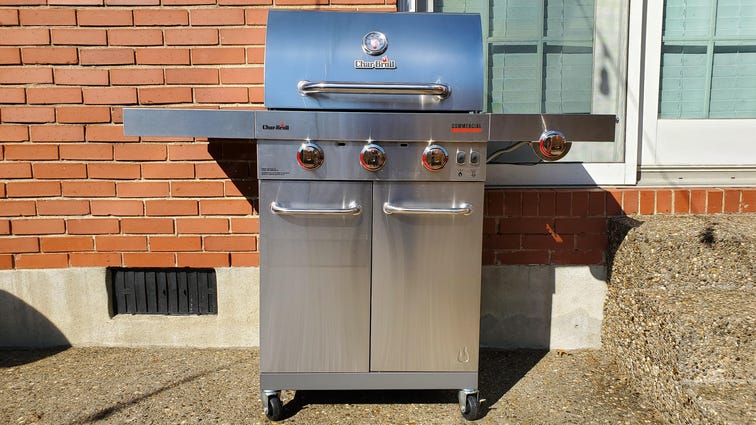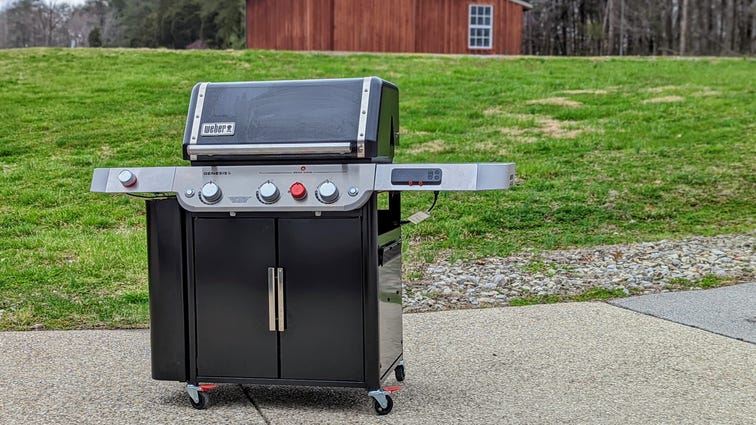
Summer is nearly here and that means it's time to get ready for barbecue season. If you're looking to maximize your outdoor kitchen, it might be time to upgrade your grill. There's no shortage of options to choose from, too, between pellet grills, portable grills and even traditional charcoal grills. However, an easy-to-use gas cooker remains the gold standard when it comes to backyard grilling.
Gas grills are simple to use, making them perfect for newbies. They ignite fast and heat up quickly. Most have plenty of room to fix a feast for the entire family, too. If you're worried about limited backyard space, it's not hard to track down a compact model to fuel your outdoor cooking adventures. Some of today's gas grills also come jam-packed with nifty extras, from side burners to special sear stations to built-in lighting for evening cooking.
So if you're on the hunt for a quality gas grill, you're in luck. We put a bunch of the bestselling models through their paces by using them to cook up burgers, whole chickens, ribs and more. When all the smoke cleared, we picked our favorites. This list is updated periodically.
This Weber Genesis II liquid propane gas grill is pricey. We won't skip over that. However, if you're serious about grilling and ready to make an investment in your outdoor kitchen, this Weber grill is absolutely a top choice with ample grilling area and cooking grid dimensions.
This Weber model comes with plenty of high-performance specs. With 513 square inches of primary cooking space powered by 39,000 BTUs, plus a fold-down warming rack, a 12,000-BTU side burner and stainless steel rod cooking grates for heat retention, you'll never want for cooking area space. Two cabinet doors hide a two-shelf storage area below the grill for utensils and supplies. That does mean the propane tank is stored outside the grill, but the provided hanging fuel gauge and easy access felt like a bonus more than an eyesore.
The Genesis II E-335 is also one of Weber's iGrill 3 compatible models, along with other Genesis II models and the Spirit II line. This $121 accessory plugs into the front of the grill and houses up to four Bluetooth temperature probes. You can monitor the temperature probes via a companion app for iOS and Android, so you keep an eye on what's happening in your cooking area from a distance.
In our testing, the Genesis II E-335 liquid propane grill turned out seared burgers with a slightly pink center, crispy chicken skin with juicy meat and fall-off-the-bone ribs. Combine that great grilling performance with Weber's 10-year warranty on all grill parts, and this propane gas grill with cast iron grate will have you set for years to come, even with heavy use.
Char-Broil's three-burner stainless steel model comes in at almost half the price of the Weber model above. At $529, you'll get a liquid propane and natural gas grill that can handle most cooking challenges with ease.
Char-Broil uses what it calls Tru-Infrared, a set of perforated emitter plates that separate food from flame to evenly distribute heat and reduce flare-ups. There were definitely fewer flare-ups compared with other models in our testing, but you won't be able to see the flame when you're lighting the grill or adjusting the temperature, so keep that in mind.
You'll get less power than the Weber at 25,500 BTUs over 420 square inches of primary cooking area space, and there aren't any smart grilling features for remote monitoring. This Char-Broil model does have a side burner as well as tank storage behind two cabinet doors. Like the Weber, it comes with a 10-year warranty.
Food cooked on our Char-Broil test unit was good, though slightly less crispy and seared than the Weber. If you're looking to stay close to $500, this outdoor grill with stainless steel burner offers the best balance of features and performance among the models we've tested.
No one ever said you have to spend hundreds of dollars to be happy with your barbecue grill. Char-Griller's E3072 proves it. This model brings 40,800 BTU of power over a generous 438 square inches of cooking space, not counting a 12,000-BTU side burner.
What we noticed most in testing this grill is how quickly it got up to temperature compared with other models. It held that heat well, too. Unfortunately, that became a hindrance in our testing. Burgers and chickens were too charred on the outside, thanks to the hot cast-iron cooking grate. If you do purchase this model, keep that in mind and start out with less heat. Ribs were better, perhaps owing to the two smokestacks designed for even low and slow cooking.
There's no storage cabinet on this model. The propane tank sits behind a decorative front panel. That's an aesthetically pleasing compromise, but reaching through the side bars and around the panel to open and close the tank was frustratingly difficult. Despite those annoyances, this barbecue grill offers plenty of practicality and power for a very reasonable price.
If you're willing to spend a little more for extra features than the Weber Genesis EPX-335 is what you seek. Newly redesigned for 2022, this propane grill offers a large 787 square inches of cooking space. It also boasts three main burners rated at 39,000 BTU, a 13,000 BTU sear burner and a 12,000 BTU side burner.
We like how two of the main burners and the sear burner can form a special sear zone on command. And those who tend to cook after dark will appreciate the built-in LED lighting system. It illuminates the cooking area automatically when you pop open the hood.
Thanks to on-board Weber Connect support, this grill has smart abilities too. Linked to your home's Wi-Fi network you can use the Weber Connect app to monitor grill status from your phone. That includes internal grill temperature plus real-time readings from up to two meat probes.
During our testing, the Genesis EPX-335 seared burgers well with just a hint of pinkness at their centers. Whole chicken came out nicely cooked as well: The skin was crispy with both white and dark meat left tender and juicy.
The only hiccup we ran into was while cooking pork ribs low and slow. According to the grill's LED screen, heat levels during the cook were parked with a 10-degree range of 225 F. Our own thermocouples though pegged temperatures at grill level at about 45 degrees cooler. As a result our ribs took longer than expected: 6 hours, 30 minutes to finish.
Other grills we've tested
The CNET Smart Home editors have been cooking and serving up grill data for a few years now. In addition to the gas barbecue models above, here are the other gas grills we've tested. This list doesn't include the many models we've tested over the years that are no longer available for purchase.
- Char-Broil Signature Series four-burner: We tested this well-built and practical Char-Broil model in 2019. It was middle of the road in our testing and the new model is now priced high at $1,096. It comes with plenty of cooking space, a side burner and cabinet doors. If you're a fan of Char-Broil's grills, this model is a safe bet, but there are better grills from other brands for your money.
- KitchenAid 720-0891C: KitchenAid's style and color options are impressive, but the performance of this $299, two-burner gas grill was underwhelming in all three tests. If you're looking for a two-burner grill, the Weber Spirit II E-210 is a better choice. It's a Propane gas grill but can also be converted to natural gas.
- Napoleon Rogue three-burner: Despite its cool looks and sturdy construction, this Napoleon model was underwhelming in our tests. At $923, it's pricey and the Char-Broil 3-burner we tested delivered better results.
- Dyna-glo five-burner: This five-burner has plenty of power, with 63,000 BTU and a turbo burner with porcelain cast-iron grate cooking surface for searing. Still, we found cooking to be uneven, not to mention small quirks like side shelves that don't fold down, a weird "condiment storage" hole and no dedicated tank space that seem more significant, even at a reasonable $299.
How we test gas grills
To determine the best gas grill and get a feel for how these grills perform in a variety of cooking scenarios, we perform three tests. Based on different meats, methods and heat settings, these tests show us how efficiently and evenly a grill does (or doesn't) cook.
Ribs
Our first test is ribs. It's an anecdotal round, so there isn't a connected thermometer set or software capturing specific data. We preheat each grill on high for 10 minutes before turning it down to low, indirect heat. Depending on the grill size, that means turning one or two burners off completely.
We remove the outer membrane on a rack of pork back ribs and season it with an all-purpose rub we use for ribs and chicken. Then, the ribs are placed on the grates for at least three hours with the lid closed the entire time.
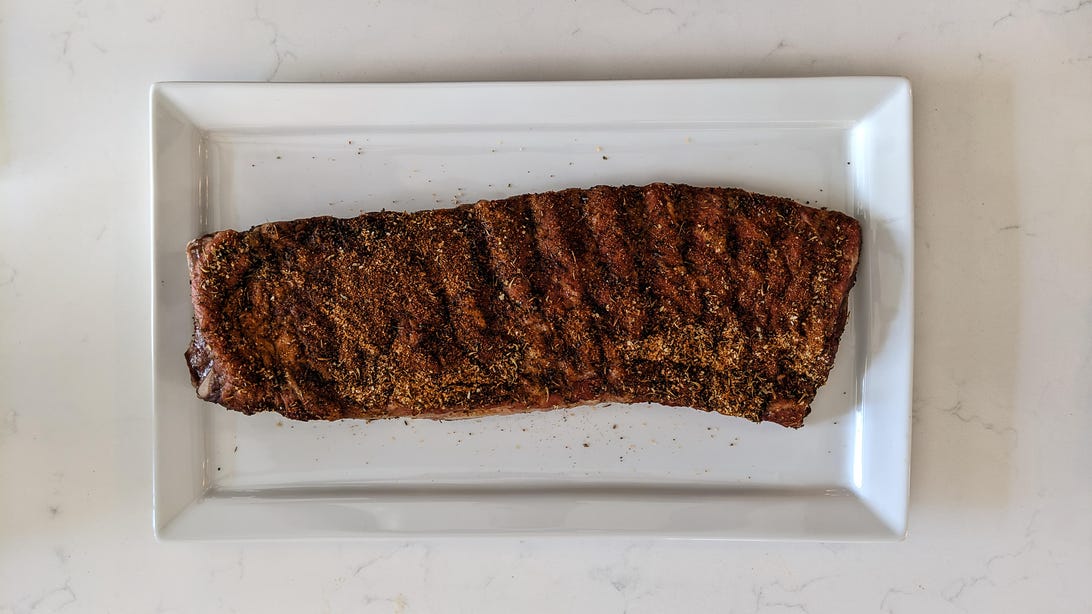
Rib testing takes three hours on low, indirect heat.
Chris Monroe/CNETRib enthusiasts may not agree with this relatively short and smoke-free cooking method, but it allows us to see just how well a regular propane gas grill can cook low and slow. If time allows we continue cooking until the ribs are completely done and make note of the total cook time.
Chicken
To test the grill with a midrange cook time and medium heat settings, we grill a whole chicken. We preheat the grill on high for 10 minutes, then turn the heat down to medium and turn off burners to create an indirect heat environment.
Once we've trimmed and seasoned the bird, we place it in a roasting pan and insert one temperature probe into each chicken breast, for a total of two probes per chicken (this is an important step -- even if the grill has a built-in thermometer -- because undercooked chicken is no good for anyone). To keep our results as fair as possible, all the chickens are as close as possible to 5.5 pounds.
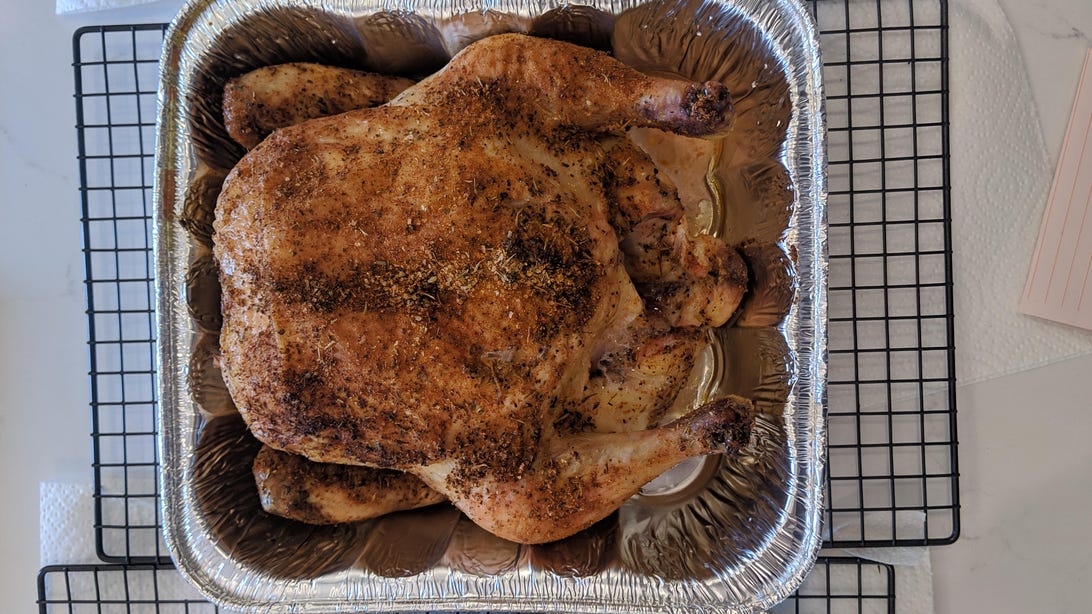
Whole chickens are cooked on indirect, medium heat until both breasts reach 165 degrees F.
Chris Monroe/CNETThose temperature probes are connected to a data logger and laptop with software that records the internal temperature of each chicken breast every two seconds. Each chicken cooks until the temperature in both breasts reaches a food-safe 165 degrees Fahrenheit.
Grilled chicken should have a crispy skin and meat that is cooked through fully but not dry. We perform this test in three rounds, giving us a solid average cooking time for each grill.
Burgers
Burgers are our final test for our grill reviews. We measure out 5.3 ounces of 80/20 ground beef and press them into uniform patties. Those patties go into a grill basket and we insert a temperature probe into the center of each patty at a 45-degree angle.
With the grill preheated for 10 minutes on high, the basket goes onto the grill. After six minutes of cooking, we flip the basket and monitor internal temperature. Once the last burger in the basket reaches 145 degrees Fahrenheit, the batch is finished. A good burger in this test is one that has both a nice outside char and a slightly pink center.
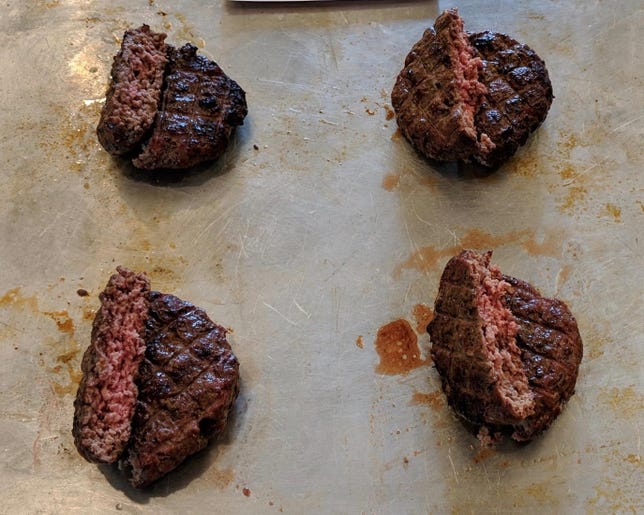
Burgers go on the grill over direct, high heat.
Brian Bennett/CNETBurger testing points out any hot spots across the grill's cooking surface if one burger consistently reaches 145 F before the others in every round.
An average 15- or 20-degree difference across the quickest and slowest patties in a batch was the norm in our testing. Red flags are raised when we begin to see differences in the 30- to 40-degree range.
A closer look at specs
Comparing these gas grills isn't all apples to apples. With different grill sizes, cooking grates and BTU levels, a difference in performance is expected in each individual outdoor gas grill. Still, there are some observations to be made.
One thing our test data highlights is how quickly a grill can cook on its own medium or high setting. That doesn't mean each grill is set to the same preheated temperature. It simply means we turned the knobs to what each grill indicated was medium heat.
The chart below compares each grill's average cooking time for chicken and burgers over three identical tests. We run the clock until the last burger reaches 145˚F and the lowest chicken breast reaches 165˚F.
Average cooking times
|
|
Weber | Char-Griller | Char-Broil | Napoleon | Dyna-Glo |
|---|---|---|---|---|---|
| Chicken | 78 min | 81 min | 59 min | 95 min | 46 min |
| Burgers | 11 min | 9 min | 13 min | 15 min | 8 min |
If speed isn't your deciding factor, don't fear. There are other characteristics you can compare to choose the grill that's right for you.
Exactly which one is that? It depends on your cooking style. If you're cooking for large groups frequently, you'll need a grill with a large primary cooking surface, a warming rack and a side burner. Some of you might also have strong feelings about the cooking grates -- you need stainless steel, or cast-iron grates, or porcelain-coated grates, or even porcelain-coated cast iron.
Look carefully at each description to be sure you get what you're looking for. If you just plan to use your grill for flipping a few burgers occasionally, stick with a less expensive or smaller gas grill model. And of course, if you're looking for a portable gas grill or an indoor grill, these won't be right for you.
Once you've picked out the best grill for you, don't forget accessories. You'll want to look at grill covers and pick up grilling tools like a grill brush, a thermometer to check for food-safe temperatures and liners for the drip tray. Take a look at this chart to compare size, power, warranty and more.
Gas grills compared
|
|
Weber | Char-Griller | Char-Broil | Napoleon | Dyna-Glo |
|---|---|---|---|---|---|
| Price | $979 | $249 | $529 | $699 | $279 |
| Dimensions (HxWxD) inches | 47x59x29 | 49x49x28 | 47x53x23 | 48x51x25 | 47x55x24 |
| Main burner BTUs | 39,000 | 40,800 | 25,500 | 36,000 | 63,000 |
| Side burner | yes | yes | yes | yes | yes |
| Warranty | 10 years | 5 years | 10 years | 15 years | 1 year |
| Primary cooking space (sq. in) | 513 | 438 | 420 | 425 | 473 |









 Add Category
Add Category
